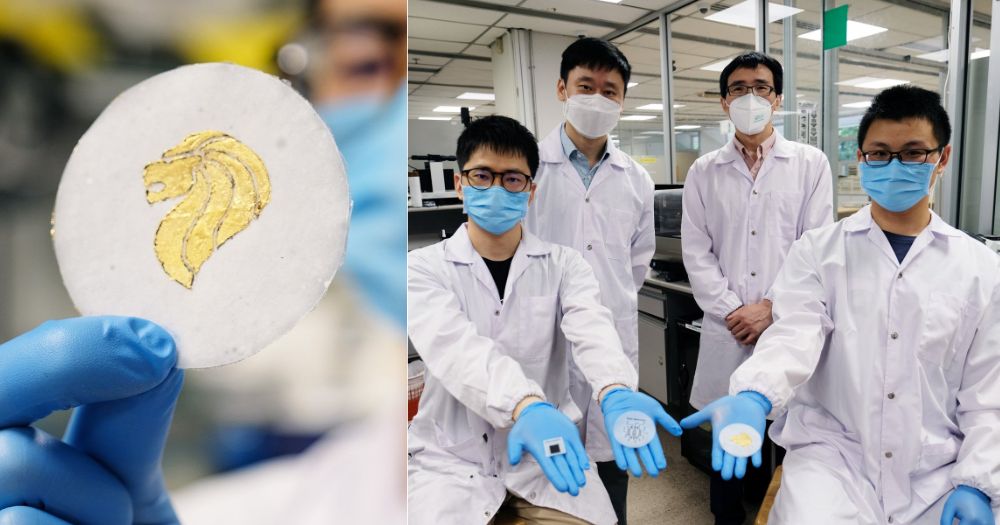Follow us on Telegram for the latest updates: https://t.me/mothershipsg
Scientists from Nanyang Technological University (NTU) have developed a battery.
And not just any regular ol' battery, but an eco-friendly battery that is as thin as a piece of paper, cheaper, and also biodegradable.
 Image courtesy of NTU Singapore.
Image courtesy of NTU Singapore.
What is a printed paper battery?
The NTU new release on Dec. 14, 2021, described the battery printed on paper, or printed paper battery, as a sandwich.
Like what makes a good sandwich – ingredients plastered between two slices of bread – the printed paper battery comprises a cellulose paper that is sandwiched between the respective electrodes.
 Image from paper published on Wiley Online Library.
Image from paper published on Wiley Online Library.
Just like a conventional battery, the printed paper battery also has an anode and a cathode, or a negative and positive terminal respectively, that electrolytes flow between.
These are the conditions required for the electrochemical reaction to produce electrical energy.
The anode or cathode are each printed on an opposite side of the cellulose paper, which has been reinforced with hydrogel to seal up the gaps naturally found in the cellulose fibres.
The hydrogel also acts as a protective separator that prevents the cathodes and anodes from mixing, and prevents short circuits.
 Image from paper published on Wiley Online Library.
Image from paper published on Wiley Online Library.
According to the news release, the anode ink is mainly made up of zinc and electrically conductive carbon black, while the cathode ink on the other side can be made of manganese or any other metals.
After the electrodes are printed on, the battery is immersed in an electrolyte. A layer of gold thin foil is then coated on the electrodes to determine the battery performance.
The final product is about 0.4mm thick, or the thickness of two strands of human hair.
 Image from paper published on Wiley Online Library.
Image from paper published on Wiley Online Library.
How can it be used in real life?
In one of their demonstrations, the NTU scientists were able to power a small electric fan for at least 45 minutes with a 4cm by 4cm square of printed paper battery.
Separately, the 4cm by 4cm square of printed paper battery was also able to power an LED.
The scientists found that bending, twisting, or cutting parts of the printed paper battery did not disrupt its power supply.
This means that the printed paper battery could potentially be integrated into flexible electronics such as foldable smart phones that are already on the market, or biomedical sensors for health monitoring.
The paper printed battery is also thinner and lighter than a conventional battery, which means that it could be used to power flexible and wearable electronic systems.
Breaks down in soil within a month
Once it has been expended, the printed paper battery can simply be buried in soil once it has been expended, where it will break down completely in a few weeks.
This was demonstrated by the NTU scientists, who buried it in the soil of a rooftop garden on the NTU campus, and found that the hydrogel-reinforced cellulose paper started fracturing after two weeks, and degraded completely within a month.
 Image from paper published on Wiley Online Library.
Image from paper published on Wiley Online Library.
The metals in the electrodes printed on the cellulose paper are also released as non-toxic minerals into the environment.
The disposal of these printed paper batteries are relatively easier and safer than conventional lithium batteries, which require unique and proper disposal methods and contain toxic substances that could leak and contaminate water sources.
NTU School of Physical and Mathematical Sciences and the study’s co-lead author, Fan Hongjin said:
“When decomposition happens, the electrode materials are released into the environment. The nickel or manganese used in the cathodes will remain in their oxide or hydroxide forms, which are close to the form of natural minerals. The zinc found in the anode will be naturally oxidised to form a non-toxic hydroxide."
Because the battery is "fully biodegradable" and does not come with additional packaging, unlike the metal or plastic casing of conventional batteries", the printed paper batteries developed could curb electronic waste.
NTU School of Electrical and Electronic Engineering and the study’s co-lead author, Lee Seok Woo said:
“We believe the paper battery we have developed could potentially help with the electronic waste problem, given that our printed paper battery is non-toxic and does not require aluminium or plastic casings to encapsulate the battery components."
Additionally, the printed paper batteries are cheaper to manufacture, and could cost 10 times cheaper than conventional lithium batteries, according to The Straits Times.
What's in the pipeline?
In the future, the NTU team hopes to demonstrate the complete integration of the printed paper battery to other printed electronics, electronic skins, and energy storage systems deployed in the environment.
Fan said:
"Through our study, we showed a simpler, cheaper way of manufacturing batteries, by developing a single large piece of battery that can be cut to desired shapes and sizes without loss of efficiency. These features make our paper batteries ideal for integration in the sorts of flexible electronics that are gradually being developed.”
You can watch the video of the printed paper battery below:
Other cool inventions
If you like what you read, follow us on Facebook, Instagram, Twitter and Telegram to get the latest updates.

